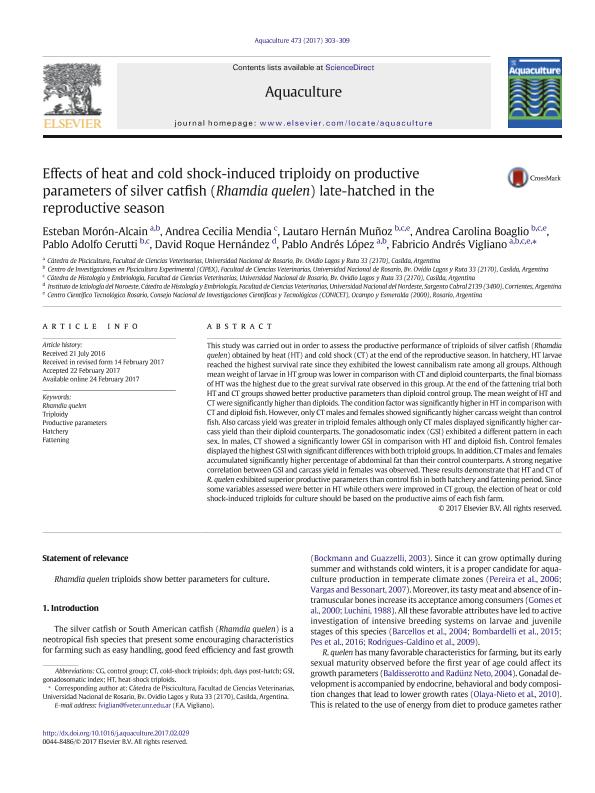Mostrar el registro sencillo del ítem
dc.contributor.author
Morón Alcain, Esteban

dc.contributor.author
Mendía Broda, Andrea Cecilia

dc.contributor.author
Muñoz, Lautaro

dc.contributor.author
Boaglio, Andrea Carolina

dc.contributor.author
Cerutti Burbe, Pablo Adolfo

dc.contributor.author
Hernandez, David Roque

dc.contributor.author
López, Pablo Andrés

dc.contributor.author
Vigliano, Fabricio Andrés

dc.date.available
2020-09-16T13:18:44Z
dc.date.issued
2017-04
dc.identifier.citation
Morón Alcain, Esteban; Mendía Broda, Andrea Cecilia; Muñoz, Lautaro; Boaglio, Andrea Carolina; Cerutti Burbe, Pablo Adolfo; et al.; Effects of heat and cold shock-induced triploidy on productive parameters of silver catfish (Rhamdia quelen) late-hatched in the reproductive season; Elsevier Science; Aquaculture; 473; 4-2017; 303-309
dc.identifier.issn
0044-8486
dc.identifier.uri
http://hdl.handle.net/11336/114075
dc.description.abstract
This study was carried out in order to assess the productive performance of triploids of silver catfish (Rhamdia quelen) obtained by heat (HT) and cold shock (CT) at the end of the reproductive season. In hatchery, HT larvae reached the highest survival rate since they exhibited the lowest cannibalism rate among all groups. Although mean weight of larvae in HT group was lower in comparison with CT and diploid counterparts, the final biomass of HT was the highest due to the great survival rate observed in this group. At the end of the fattening trial both HT and CT groups showed better productive parameters than diploid control group. The mean weight of HT and CT were significantly higher than diploids. The condition factor was significantly higher in HT in comparison with CT and diploid fish. However, only CT males and females showed significantly higher carcass weight than control fish. Also carcass yield was greater in triploid females although only CT males displayed significantly higher carcass yield than their diploid counterparts. The gonadosomatic index (GSI) exhibited a different pattern in each sex. In males, CT showed a significantly lower GSI in comparison with HT and diploid fish. Control females displayed the highest GSI with significant differences with both triploid groups. In addition, CT males and females accumulated significantly higher percentage of abdominal fat than their control counterparts. A strong negative correlation between GSI and carcass yield in females was observed. These results demonstrate that HT and CT of R. quelen exhibited superior productive parameters than control fish in both hatchery and fattening period. Since some variables assessed were better in HT while others were improved in CT group, the election of heat or cold shock-induced triploids for culture should be based on the productive aims of each fish farm.
dc.format
application/pdf
dc.language.iso
eng
dc.publisher
Elsevier Science

dc.rights
info:eu-repo/semantics/openAccess
dc.rights.uri
https://creativecommons.org/licenses/by-nc-sa/2.5/ar/
dc.subject
FATTENING
dc.subject
HATCHERY
dc.subject
PRODUCTIVE PARAMETERS
dc.subject
RHAMDIA QUELEN
dc.subject
TRIPLOIDY
dc.subject.classification
Ciencias Veterinarias

dc.subject.classification
Ciencias Veterinarias

dc.subject.classification
CIENCIAS AGRÍCOLAS

dc.title
Effects of heat and cold shock-induced triploidy on productive parameters of silver catfish (Rhamdia quelen) late-hatched in the reproductive season
dc.type
info:eu-repo/semantics/article
dc.type
info:ar-repo/semantics/artículo
dc.type
info:eu-repo/semantics/publishedVersion
dc.date.updated
2020-09-03T16:52:15Z
dc.journal.volume
473
dc.journal.pagination
303-309
dc.journal.pais
Países Bajos

dc.journal.ciudad
Amsterdam
dc.description.fil
Fil: Morón Alcain, Esteban. Universidad Nacional de Rosario. Facultad de Ciencias Veterinarias; Argentina
dc.description.fil
Fil: Mendía Broda, Andrea Cecilia. Consejo Nacional de Investigaciones Científicas y Técnicas. Centro Científico Tecnológico Conicet - Rosario; Argentina. Universidad Nacional de Rosario. Facultad de Ciencias Veterinarias. Departamento de Ciencias Básicas. Cátedra de Histología y Embriología; Argentina
dc.description.fil
Fil: Muñoz, Lautaro. Consejo Nacional de Investigaciones Científicas y Técnicas. Centro Científico Tecnológico Conicet - Rosario; Argentina. Universidad Nacional de Rosario. Facultad de Ciencias Veterinarias. Departamento de Ciencias Básicas. Cátedra de Histología y Embriología; Argentina
dc.description.fil
Fil: Boaglio, Andrea Carolina. Consejo Nacional de Investigaciones Científicas y Técnicas. Centro Científico Tecnológico Conicet - Rosario; Argentina. Universidad Nacional de Rosario. Facultad de Ciencias Veterinarias. Departamento de Ciencias Básicas. Cátedra de Histología y Embriología; Argentina
dc.description.fil
Fil: Cerutti Burbe, Pablo Adolfo. Universidad Nacional del Nordeste. Facultad de Ciencias Veterinarias. Instituto de Ictiología del Nordeste; Argentina
dc.description.fil
Fil: Hernandez, David Roque. Consejo Nacional de Investigaciones Científicas y Técnicas; Argentina. Universidad Nacional del Nordeste. Facultad de Ciencias Veterinarias. Instituto de Ictiología del Nordeste; Argentina
dc.description.fil
Fil: López, Pablo Andrés. Universidad Nacional de Rosario. Facultad de Ciencias Veterinarias; Argentina
dc.description.fil
Fil: Vigliano, Fabricio Andrés. Consejo Nacional de Investigaciones Científicas y Técnicas. Centro Científico Tecnológico Conicet - Rosario; Argentina. Universidad Nacional de Rosario. Facultad de Ciencias Veterinarias; Argentina
dc.journal.title
Aquaculture

dc.relation.alternativeid
info:eu-repo/semantics/altIdentifier/url/https://www.sciencedirect.com/science/article/pii/S0044848617303472
dc.relation.alternativeid
info:eu-repo/semantics/altIdentifier/doi/https://doi.org/10.1016/j.aquaculture.2017.02.029
Archivos asociados
